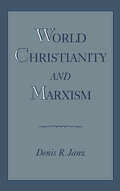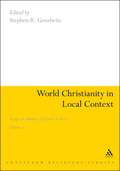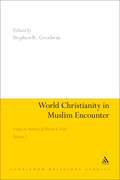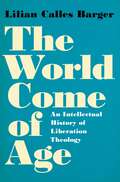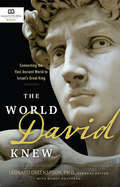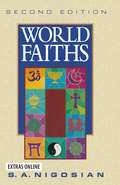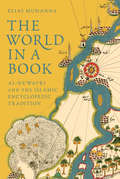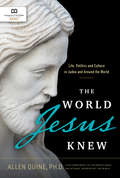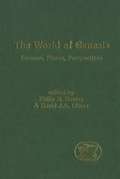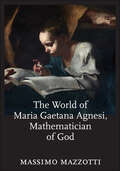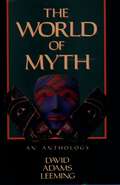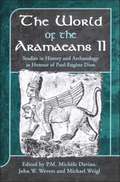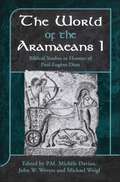- Table View
- List View
World Christianity and Marxism
by Denis R. JanzDenis Janz argues that the encounter with Marxism has been the defining event for twentieth century Christianity. No other worldview shook Christianity more dramatically and no other movement had as profound an impact on so many. Now the Cold War is over and as we approach the end of the century we need, Janz says, to ask ourselves what happened. This book is the first unified and comprehensive attempt to analyze this historic meeting between these two antagonistic worlds of thought and action. The intellectual foundation of this antagonism is to be found in Karl Marx himself, and thus the book begins with an account of Marx's assault on Christianity. All the diverse philosophical and political manifestations of Marxism were ultimately rooted in Marx's thought, and supporters based their greater or lesser hostilities toward Christianity on their reading of his critique. Janz follows this with an overview of Christian responses to Marx, extending from the mid-19th century to the onset of the Cold War. He argues that within this time frame Christianity's negation of Marx was not absolute; the loud "no" to Marx bore with it an important, if muted, "yes." With this intellectual groundwork in place, Janz turns to an examination of the encounter as it unfolded in specific national contexts: the United States, the Soviet Union, Poland, Nicaragua, Cuba, China, and Albania. The experiences of these countries varied widely, from Poland where Christianity maintained its strongest independence, to Nicaragua where a Christian alliance with Marxism contributed to revolutionary change, to Albania where a Stalinist government attempted to abolish religion entirely. From this survey emerges the evidence that world Christianity has clearly internalized some of the prominent features of its antagonist, suggesting that the "Marxist project" is not as utterly defunct as many have assumed.
World Christianity in Local Context: Essays in Memory of David A. Kerr Volume 1
by Stephen R. GoodwinGlobal Christianity in Local Context is the first volume of a unique collection of essays in honour of David A. Kerr, well-known for his contributions in the areas of Christian-Muslim dialogue, Ecumenical Studies and Missions. With contributions from recognized experts in these fields, the book provides a platform for examining contemporary Christian-Muslim relations and critical issues facing twenty-first century Christianity. In Volume 1, scholars and Church leaders offer insights into current trends in Local Theology and Missions from the contexts of Asia, Africa, Latin America and Europe.
World Christianity in Local Context: Essays in Memory of David A. Kerr Volume 1 (Continuum Religious Studies)
by Stephen R. GoodwinGlobal Christianity in Local Context is the first volume of a unique collection of essays in honour of David A. Kerr, well-known for his contributions in the areas of Christian-Muslim dialogue, Ecumenical Studies and Missions. With contributions from recognized experts in these fields, the book provides a platform for examining contemporary Christian-Muslim relations and critical issues facing twenty-first century Christianity. In Volume 1, scholars and Church leaders offer insights into current trends in Local Theology and Missions from the contexts of Asia, Africa, Latin America and Europe.
World Christianity in Muslim Encounter: Essays in Memory of David A. Kerr Volume 2
by Stephen R. GoodwinGlobal Christianity in Local Context and Muslim Encounter is a unique collection of essays in honour of David A. Kerr, well-known for his contributions in the areas of Christian-Muslim dialogue, Ecumenical Studies and Missions. With contributions from recognized experts in these fields, the book provides a platform for examining contemporary Christian-Muslim relations and critical issues facing twenty-first century Christianity. Volume 2 is a veritable Who's Who of renowned Christian and Muslim scholars that have shaped the course of Christian-Muslim dialogue over the last half century. Their contributions in this volume address contemporary and pivotal issues facing Christians and Muslims today, such as Islamophobia, Islamism, Religious Freedom, Inter-religious Challenges and Urbanism, Mission and Economic Globalisation, Suffering and Social Responsibility, and others.
World Christianity in Muslim Encounter: Essays in Memory of David A. Kerr Volume 2
by Stephen R. GoodwinGlobal Christianity in Local Context and Muslim Encounter is a unique collection of essays in honour of David A. Kerr, well-known for his contributions in the areas of Christian-Muslim dialogue, Ecumenical Studies and Missions. With contributions from recognized experts in these fields, the book provides a platform for examining contemporary Christian-Muslim relations and critical issues facing twenty-first century Christianity. Volume 2 is a veritable Who's Who of renowned Christian and Muslim scholars that have shaped the course of Christian-Muslim dialogue over the last half century. Their contributions in this volume address contemporary and pivotal issues facing Christians and Muslims today, such as Islamophobia, Islamism, Religious Freedom, Inter-religious Challenges and Urbanism, Mission and Economic Globalisation, Suffering and Social Responsibility, and others.
The World Come of Age: An Intellectual History of Liberation Theology
by Lilian Calles BargerOn November 16, 2017, Pope Francis tweeted, "Poverty is not an accident. It has causes that must be recognized and removed for the good of so many of our brothers and sisters." With this statement and others like it, the first Latin American pope was associated, in the minds of many, with a stream of theology that swept the Western hemisphere in the 1960s and 70s, the movement known as liberation theology. Born of chaotic cultural crises in Latin America and the United States, liberation theology was a trans-American intellectual movement that sought to speak for those parts of society marginalized by modern politics and religion by virtue of race, class, or sex. Led by such revolutionaries as the Peruvian Catholic priest Gustavo Gutiérrez, the African American theologian James Cone, or the feminists Mary Daly and Rosemary Radford Ruether, the liberation theology movement sought to bridge the gulf between the religious values of justice and equality and political pragmatism. It combined theology with strands of radical politics, social theory, and the history and experience of subordinated groups to challenge the ideas that underwrite the hierarchical structures of an unjust society. Praised by some as a radical return to early Christian ethics and decried by others as a Marxist takeover, liberation theology has a wide-raging, cross-sectional history that has previously gone undocumented. In The World Come of Age, Lilian Calles Barger offers for the first time a systematic retelling of the history of liberation theology, demonstrating how a group of theologians set the stage for a torrent of new religious activism that challenged the religious and political status quo.
The World Come of Age: An Intellectual History of Liberation Theology
by Lilian Calles BargerOn November 16, 2017, Pope Francis tweeted, "Poverty is not an accident. It has causes that must be recognized and removed for the good of so many of our brothers and sisters." With this statement and others like it, the first Latin American pope was associated, in the minds of many, with a stream of theology that swept the Western hemisphere in the 1960s and 70s, the movement known as liberation theology. Born of chaotic cultural crises in Latin America and the United States, liberation theology was a trans-American intellectual movement that sought to speak for those parts of society marginalized by modern politics and religion by virtue of race, class, or sex. Led by such revolutionaries as the Peruvian Catholic priest Gustavo Gutiérrez, the African American theologian James Cone, or the feminists Mary Daly and Rosemary Radford Ruether, the liberation theology movement sought to bridge the gulf between the religious values of justice and equality and political pragmatism. It combined theology with strands of radical politics, social theory, and the history and experience of subordinated groups to challenge the ideas that underwrite the hierarchical structures of an unjust society. Praised by some as a radical return to early Christian ethics and decried by others as a Marxist takeover, liberation theology has a wide-raging, cross-sectional history that has previously gone undocumented. In The World Come of Age, Lilian Calles Barger offers for the first time a systematic retelling of the history of liberation theology, demonstrating how a group of theologians set the stage for a torrent of new religious activism that challenged the religious and political status quo.
The World David Knew: Connecting the Vast Ancient World to Israel's Great King
by Museum of the Bible Books Randy SouthernImmerse yourself in the captivating world of 1000 BC AS Everyone watches the small nation of Israel make it's move after the death of it's beloved King David. Shepherd. Warrior. King. Psalmist. Father. Fugitive. Hero. Villain. No single word is sufficient to encompass Israel's King David. The World David Knew offers a snapshot of life during this key period in the nation's history. The World David Knew provides you with vivid details of life in 1000 BC, including elements of numerous cultures around the world. Hold your breath as some of the biggest political power shifts in history are made. Celebrate along with the people of Israel as they go to weddings and holiday feasts. Understand how nations traded goods, services, and money. What will the future hold for the nation of Israel, and the greater world?
World Faiths
by S.A. NigosianWorld Faiths is a brief introduction to the major world religions. The book provides detailed coverage of the historical development of different religious traditions, and, for each religion, presents issues of faith from the perspective of the believer.
World Faiths - An Introduction: An Introduction (Teach Yourself)
by Paul OliverThis book is a concise guide to the major religions around the world. Become familiar with the history of each faith, its core beliefs, and how it is practised today. Whether you're studying theology or just want to know more about the faiths that shape our world, this clearly structured guide offers everything you need to get started.NOT GOT MUCH TIME?One, five and ten-minute introductions to key principles to get you started.AUTHOR INSIGHTSLots of instant help with common problems and quick tips for success, based on the author's many years of experience.TEST YOURSELFTests in the book and online to keep track of your progress.EXTEND YOUR KNOWLEDGEExtra online articles at www.teachyourself.com to give you a richer understanding of psychology.FIVE THINGS TO REMEMBERQuick refreshers to help you remember the key facts.TRY THISInnovative exercises illustrate what you've learnt and how to use it.
World History and the Mysteries: In the Light of Anthroposophy
by Rudolf SteinerIn this landmark series of lectures, Rudolf Steiner challenges the notion that human consciousness has in essence remained the same throughout history. On the contrary, we can only see the past in its true light when we study the differences in human souls during the various historical eras. Consciousness, he says, evolves constantly and we can only comprehend the present by understanding its origin in the past.Delivered in the evenings during the course of the ‘mystery act’ of the Christmas Foundation Meeting – when Rudolf Steiner not only re-founded the Anthroposophical Society but for the first time took a formal role within it – these lectures study world history in parallel with the ancient mysteries of initiation, showing how they are intimately linked. Steiner describes consciousness in the ancient East and follows the initiation principle from Babylonia to Greece, up to its influences in present-day spiritual life. He also discusses Gilgamesh and Eabani, the mysteries of Ephesus and Hibernia, and the occult relationship between the destruction by fire of the Temple of Artemis and the burning of the first Goetheanum in Dornach, Switzerland.Published for the first time with colour plates of Steiner’s blackboard drawings, the freshly-revised text is complemented with an introduction, notes and appendices by Professor Frederick Amrine and an index.
The World in a Book: Al-Nuwayri and the Islamic Encyclopedic Tradition
by Elias MuhannaShihab al-Din al-Nuwayri was a fourteenth-century Egyptian polymath and the author of one of the greatest encyclopedias of the medieval Islamic world—a thirty-one-volume work entitled The Ultimate Ambition in the Arts of Erudition. A storehouse of knowledge, this enormous book brought together materials on nearly every conceivable subject, from cosmology, zoology, and botany to philosophy, poetry, ethics, statecraft, and history. Composed in Cairo during the golden age of Islamic encyclopedic activity, the Ultimate Ambition was one of hundreds of large-scale compendia, literary anthologies, dictionaries, and chronicles produced at this time—an effort that was instrumental in organizing the archive of medieval Islamic thought.In the first study of this landmark work in a European language, Elias Muhanna explores its structure and contents, sources and influences, and reception and impact in the Islamic world and Europe. He sheds new light on the rise of encyclopedic literature in the learned cities of the Mamluk Empire and situates this intellectual movement alongside other encyclopedic traditions in the ancient, medieval, Renaissance, and Enlightenment periods. He also uncovers al-Nuwayri’s world: a scene of bustling colleges, imperial chanceries, crowded libraries, and religious politics.Based on award-winning scholarship, The World in a Book opens up new areas in the comparative study of encyclopedic production and the transmission of knowledge.
The World in a Book: Al-Nuwayri and the Islamic Encyclopedic Tradition
by Elias MuhannaShihab al-Din al-Nuwayri was a fourteenth-century Egyptian polymath and the author of one of the greatest encyclopedias of the medieval Islamic world—a thirty-one-volume work entitled The Ultimate Ambition in the Arts of Erudition. A storehouse of knowledge, this enormous book brought together materials on nearly every conceivable subject, from cosmology, zoology, and botany to philosophy, poetry, ethics, statecraft, and history. Composed in Cairo during the golden age of Islamic encyclopedic activity, the Ultimate Ambition was one of hundreds of large-scale compendia, literary anthologies, dictionaries, and chronicles produced at this time—an effort that was instrumental in organizing the archive of medieval Islamic thought.In the first study of this landmark work in a European language, Elias Muhanna explores its structure and contents, sources and influences, and reception and impact in the Islamic world and Europe. He sheds new light on the rise of encyclopedic literature in the learned cities of the Mamluk Empire and situates this intellectual movement alongside other encyclopedic traditions in the ancient, medieval, Renaissance, and Enlightenment periods. He also uncovers al-Nuwayri’s world: a scene of bustling colleges, imperial chanceries, crowded libraries, and religious politics.Based on award-winning scholarship, The World in a Book opens up new areas in the comparative study of encyclopedic production and the transmission of knowledge.
The World Jesus Knew: Life, Politics, and Culture in Judea and Around the World
by Seth PolingerJesus lived in a time of great tension and upheaval. It is estimated there were approximately 700,000 Jews then living in Israel under the Roman occupation. Discover the complexities of life in a tiny Nazereth village. Compelling narrative brings to light the rapidly developing cultures throughout the world. The World Jesus Knew immerses the modern reader in the worldwide drama of the first century and depicts an era of global conquest and domination.
World of Faith and Freedom: Why International Religious Liberty Is Vital to American National Security
by Thomas F. FarrVirtually every trouble spot on the planet has some sort of religious component. One need only consider Iraq and Afghanistan, Iran, Israel and Palestine, Turkey, India, Pakistan, Russia, and China, to name but a few. Looming behind national issues, of course, is the problem of regional Islamist extremism and transnational Islamist terrorism. In all of these sectors, religious tensions, ideas and actors are of great geo-political importance to the United States. Yet, argues Thomas Farr, our foreign policy is gravely handicapped by an inability to understand the role of religion either nationally or globally. There is a strong disinclination in American diplomacy to consider religious factors at all, either as part of the problem or part of the solution. In this engaging and well-written insider account, Farr offers a closely reasoned argument that religious freedom, the freedom to practice one's own religion in private and in public, is an essential prerequisite for a stable, durable democratic society. If the U.S. wants to foster democracy that lasts, he says, it must focus on fostering religious liberty, especially in its public manifestations, properly limited in a way that advances the common good. Although we ourselves have developed a remarkably successful model of religious freedom, our foreign policy favors an aggressive secularism that is at odds with the American model. It is essential, says Farr, that we take an approach that recognizes the great importance of religion in people's lives.
World of Faith and Freedom: Why International Religious Liberty Is Vital to American National Security
by Thomas F. FarrVirtually every trouble spot on the planet has some sort of religious component. One need only consider Iraq and Afghanistan, Iran, Israel and Palestine, Turkey, India, Pakistan, Russia, and China, to name but a few. Looming behind national issues, of course, is the problem of regional Islamist extremism and transnational Islamist terrorism. In all of these sectors, religious tensions, ideas and actors are of great geo-political importance to the United States. Yet, argues Thomas Farr, our foreign policy is gravely handicapped by an inability to understand the role of religion either nationally or globally. There is a strong disinclination in American diplomacy to consider religious factors at all, either as part of the problem or part of the solution. In this engaging and well-written insider account, Farr offers a closely reasoned argument that religious freedom, the freedom to practice one's own religion in private and in public, is an essential prerequisite for a stable, durable democratic society. If the U.S. wants to foster democracy that lasts, he says, it must focus on fostering religious liberty, especially in its public manifestations, properly limited in a way that advances the common good. Although we ourselves have developed a remarkably successful model of religious freedom, our foreign policy favors an aggressive secularism that is at odds with the American model. It is essential, says Farr, that we take an approach that recognizes the great importance of religion in people's lives.
The World of Genesis: Persons, Places, Perspectives (The Library of Hebrew Bible/Old Testament Studies)
by Philip R. Davies David J. ClinesAlthough it opens with an argument that the earth, and not humanity, is the real subject of Genesis 1-11, this collection of essays focuses first on female personalities in Genesis (Eve, Hagar, Rebeccah, Tamar and the four tribal matriarchs), then on male characters (Abraham, Ishmael, Pharaoh). The treatment ranges from historical-critical analysis, through discourse analysis and narrative, ideological and psychological analyses, to postmodern autobiographical exegesis. Among the many delights of this selection are the mingling of traditional and contemporary perspectives, especially the interplay of gender at the level of the biblical text and of the modern author-and perhaps also of the modern reader of this fascinating assortment of studies on tales of human ancestry.
The world of Genesis (Large Print)
This image shows a map of the ancient Middle East. There is a locator dot shown, which will be at the top left when the image is the correct way up. The map is surrounded by an image border. The Mediterranean Sea is in the top left quarter of the page. Part of the Caspian Sea is in the top right of the page. Part of the Persian Gulf is towards the bottom right of the page. The Red Sea is in bottom centre of the page. The land is not textured. As it is today, southern Greece is in the top left of the page and north east Africa in the bottom left quarter of the page. Modern day Israel would be in the centre of the image. The rivers Euphrates and Tigris are shown as wiggly lines running from the top centre of the page, diagonally down and right, to the Persian Gulf. The river Nile runs up the page as a wiggly line from the bottom of the page just left from the Red Sea. There is a north arrow in the top left corner and a scale in the bottom left corner.
The world of Genesis (UEB Uncontracted)
This image shows a map of the ancient Middle East. There is a locator dot shown, which will be at the top left when the image is the correct way up. The map is surrounded by an image border. The Mediterranean Sea is in the top left quarter of the page. Part of the Caspian Sea is in the top right of the page. Part of the Persian Gulf is towards the bottom right of the page. The Red Sea is in bottom centre of the page. The land is not textured. As it is today, southern Greece is in the top left of the page and north east Africa in the bottom left quarter of the page. Modern day Israel would be in the centre of the image. The rivers Euphrates and Tigris are shown as wiggly lines running from the top centre of the page, diagonally down and right, to the Persian Gulf. The river Nile runs up the page as a wiggly line from the bottom of the page just left from the Red Sea. There is a north arrow in the top left corner and a scale in the bottom left corner.
The World of Maria Gaetana Agnesi, Mathematician of God (Johns Hopkins Studies in the History of Mathematics #2)
by Massimo MazzottiShe is best known for her curve, the witch of Agnesi, which appears in almost all high school and undergraduate math books. She was a child prodigy who frequented the salon circuit, discussing mathematics, philosophy, history, and music in multiple languages. She wrote one of the first vernacular textbooks on calculus and was appointed chair of mathematics at the university in Bologna. In later years, however, she became a prominent figure within the Catholic Enlightenment, gave up academics, and devoted herself to the poor, the sick, the hungry, and the homeless. Indeed, the life of Maria Agnesi reveals a complex and enigmatic figure—one of the most fascinating characters in the history of mathematics. Using newly discovered archival documents, Massimo Mazzotti reconstructs the wide spectrum of Agnesi's social experience and examines her relationships to various traditions—religious, political, social, and mathematical. This meticulous study shows how she and her fellow Enlightenment Catholics modified tradition in an effort to reconcile aspects of modern philosophy and science with traditional morality and theology.Mazzotti's original and provocative investigation is also the first targeted study of the Catholic Enlightenment and its influence on modern science. He argues that Agnesi's life is the perfect lens through which we can gain a greater understanding of mid-eighteenth-century cultural trends in continental Europe.
The World of Myth: An Anthology
by David Adams LeemingHercules, Zeus, Thor, Gilgamesh--these are the figures that leap to mind when we think of myth. But to David Leeming, myths are more than stories of deities and fantastic beings from non-Christian cultures. Myth is at once the most particular and the most universal feature of civilization, representing common concerns that each society voices in its own idiom. Whether an Egyptian story of creation or the big-bang theory of modern physics, myth is metaphor, mirroring our deepest sense of ourselves in relation to existence itself. Now, in The World of Myth, Leeming provides a sweeping anthology of myths, ranging from ancient Egypt and Greece to the Polynesian islands and modern science. We read stories of great floods from the ancient Babylonians, Hebrews, Chinese, and Mayans; tales of apocalypse from India, the Norse, Christianity, and modern science; myths of the mother goddess from Native American Hopi culture and James Lovelock's Gaia. Leeming has culled myths from Aztec, Greek, African, Australian Aboriginal, Japanese, Moslem, Hittite, Celtic, Chinese, and Persian cultures, offering one of the most wide-ranging collections of what he calls the collective dreams of humanity. More important, he has organized these myths according to a number of themes, comparing and contrasting how various societies have addressed similar concerns, or have told similar stories. In the section on dying gods, for example, both Odin and Jesus sacrifice themselves to renew the world, each dying on a tree. Such traditions, he proposes, may have their roots in societies of the distant past, which would ritually sacrifice their kings to renew the tribe. In The World of Myth, David Leeming takes us on a journey "not through a maze of falsehood but through a marvellous world of metaphor," metaphor for "the story of the relationship between the known and the unknown, both around us and within us." Fantastic, tragic, bizarre, sometimes funny, the myths he presents speak of the most fundamental human experience, a part of what Joseph Campbell called "the wonderful song of the soul's high adventure."
The World of Saint Patrick
by Philip FreemanThe legend of Saint Patrick is irresistibly captivating-he drove the snakes out of Ireland, battled the druids, and used the three-leaf Shamrock to convert the pagan Irish to belief in the Christian Trinity. Yet, as so often happens, these stories are mere myths that fold under closer scrutiny. Snakes never plagued the Irish countryside, and the Emerald Isle's most beloved saint wasn't even Irish but a Briton of the Roman nobility. Fortunately, the truth is even more fascinating. In The World of Saint Patrick, classical scholar Philip Freeman offers the definitive account of Saint Patrick's life through new and vibrant translations of the greatest works of early Christian Ireland. This story of great violence, brutality, and even greater faith begins with two letters Patrick wrote describing his kidnapping by pirates at age sixteen and subsequent slavery. Although his grandfather was a priest and his father a deacon, at the time of his kidnapping Patrick had rejected his childhood faith in favor of atheism. Yet in this deeply moving narrative, Patrick recounts how he regained his faith during his captivity, and how the voice of God guided him both in his escape from bondage and in his eventual return to Ireland as a missionary to the very people who had enslaved him. The World of Saint Patrick delves into colorful tales of Patrick's struggles with pagan kings, soaring hymns of praise, and a prayer of protection against forces of evil such as "the magic of women, blacksmiths, and druids." Freeman also examines the life of Saint Brigid, Ireland's first female saint, and the legendary voyage of Saint Brendan and his monks across the western ocean. Both general readers with an interest in Ireland's saints and scholars studying religion or medieval history will be unable to put down this captivating tale of Ireland's greatest saint and the remarkable times in which he lived.
The World of Saint Patrick
by Philip FreemanThe legend of Saint Patrick is irresistibly captivating-he drove the snakes out of Ireland, battled the druids, and used the three-leaf Shamrock to convert the pagan Irish to belief in the Christian Trinity. Yet, as so often happens, these stories are mere myths that fold under closer scrutiny. Snakes never plagued the Irish countryside, and the Emerald Isle's most beloved saint wasn't even Irish but a Briton of the Roman nobility. Fortunately, the truth is even more fascinating. In The World of Saint Patrick, classical scholar Philip Freeman offers the definitive account of Saint Patrick's life through new and vibrant translations of the greatest works of early Christian Ireland. This story of great violence, brutality, and even greater faith begins with two letters Patrick wrote describing his kidnapping by pirates at age sixteen and subsequent slavery. Although his grandfather was a priest and his father a deacon, at the time of his kidnapping Patrick had rejected his childhood faith in favor of atheism. Yet in this deeply moving narrative, Patrick recounts how he regained his faith during his captivity, and how the voice of God guided him both in his escape from bondage and in his eventual return to Ireland as a missionary to the very people who had enslaved him. The World of Saint Patrick delves into colorful tales of Patrick's struggles with pagan kings, soaring hymns of praise, and a prayer of protection against forces of evil such as "the magic of women, blacksmiths, and druids." Freeman also examines the life of Saint Brigid, Ireland's first female saint, and the legendary voyage of Saint Brendan and his monks across the western ocean. Both general readers with an interest in Ireland's saints and scholars studying religion or medieval history will be unable to put down this captivating tale of Ireland's greatest saint and the remarkable times in which he lived.
The World of the Aramaeans: Studies in Honour of Paul-Eugène Dion, Volume 2 (The Library of Hebrew Bible/Old Testament Studies)
by P.M. Michèle Daviau Michael Weigl John W. WeversThe World of the Aramaeans is a three-volume collection of definitive essays about the Aramaeans and the biblical world of which they were a part. Areas of interest include the language, epigraphy and history of the Aramaeans of Syria as well of their neighbours, the Israelites, Phoenicians, Ammonites, Moabites and Edomites. The second volume, devoted to history and archaeology, includes contributions by Brian Peckham, Wolfgang Röllig, Carl S. Ehrlich, Guy Couturier, Stafania Mazzoni, Timothy P. Harrison, Michael Heltzer, John S. Holladay Jr., Michéle Daviau, Paolo Xella, Emile Pusch, Piotr Bienkowski, Bezalel Porten and John Gee.
The World of the Aramaeans: Studies in Honour of Paul-Eugène Dion, Volume 1 (The Library of Hebrew Bible/Old Testament Studies)
by P.M. Michèle Daviau Michael Weigl John W. WeversThe World of the Aramaeans is a three-volume collection of definitive essays about the Aramaeans and the biblical world of which they were a part. Areas of interest include the language, epigraphy and history of the Aramaeans of Syria as well of their neighbours, the Israelites, Phoenicians, Ammonites, Moabites and Edomites. The first volume, dealing with the Aramaeans in the Bible, has contributions by Douglas Frayne, Stephen Dempster, José Loza Vera, E.J. Revell, Alexander Rofé, André Lemaire, Francolino, J. Gontalves, Baruch Halpern, Raymond C. Van Leeuwen, John William Wevers, Albert Pietersma and Felice Israel.
